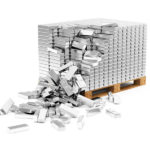Weekly Market Report 7/11/11
GOLD
Gold investors were very happy last week. Gold was up every day, increasing $58.80 per ounce (3.98%) in just one week, and closing at $1,541.60 per ounce on Friday. The price increase started in Asia and the Middle East over the 4th of July holiday after gold had bottomed out at $1,478 on July 1st. Gold continued its bull move in the U.S. on the opening Tuesday. If gold could close and stay above the $1,550 resistance level for a couple days this week, we are off and running to new all-time highs.
Technical analysts believe that a reversal like what happened last week is very bullish for the short term outlook for the Gold price. Another bullish factor for gold and silver is the GLOBAL DEBT PROBLEM. The financial media cannot stop covering the world’s debt problems. Two weeks ago it was Greece, last week it was the U.S. Debt ceiling problem, and next week it will probably be Portugal and Italy’s debt problems. These facts, combined with the upcoming historic seasonal demand, should drive gold to new all-time highs very soon.
For the past two years, from July 8th 2009 & 2010, up until December 31st 2009 & 2010, gold increased an average of 18% due to India’s religious festivals, year-end store of wealth buying, and demand from the jewelry manufacturers preparing for their holiday season, including the Chinese New Year. Last Friday, July 8th, gold closed at $1,541.60. Following the pattern of the past two years, an 18% increase would put gold at $1,819 per ounce by Decemeber 31st 2011, in line with my January prediction of $1,800.00.
SILVER
If Gold investors were happy with last week’s market increase, Silver investors were ecstatic. This is the first time in the past two months that Silver led the precious metal sector. Silver showed remarkable demand and price appreciation last week, increasing $2.83 (8.42%) an ounce to $36.54 on heavy buying, primarily from Asia. The Silver price did dip down to $33.40 on July 1st before the sizeable Asian demand kicked in again. Silver has held above $33.40 per ounce since May 18th and many of the commodity traders I speak with believe that we have established firm support at this level.
It’s become clear to me that Silver will be the biggest beneficiary of any government stimulus program and/or the next round of monetary easing from the Federal Reserve. The Fed will not call the next round of monetary easing Quantitative Easing (QE3) because of potential negative press. After Friday’s poor jobs report, and the U.S. unemployment rate (which now stands at 9.2%) along with the on-going Congressional debate over the Debt Ceiling, I would expect an announcement on one or both by the end of this August.
Starting July 15th Dodd-Frank will affect some brokers selling gold & silver products.
Over the past couple of weeks I have received emails from clients asking about any new regulations on buying/selling Gold & Silver that start next week.
Yes, there are provisions in the Dodd-Frank Wall Street Reform and Consumer Protection Act that will start July 15th which will involve gold and silver. Section 742(a) of this regulation clearly states that it does not affect buying or selling of any gold and silver coins or bars if delivery is completed within 28 days of purchase. The Dodd-Frank Act does not affect precious metal EFTs, mining stocks or funds. This legislation appears to be affecting non-accredited, U.S. traders engaged in leveraged or contract trading of Gold and Silver products with delivery dates of over 28 days. Investors can thank the Industry Council for Tangible Assets (ICTA) in Washington D.C. for providing input to the CFTC to protect gold and silver products. I am proud to say I am one of the original founders and currently a Board of Director member of ICTA.
This Week’s recommended commitment and diversification:
Precious Metal commitment: Minimum of 30% of investible capital
Diversification: Gold 60%, Silver 40%.
Diversification includes long term investment quality rare coins and short term bullion products.
RARE COINS REPORT
In this week’s Rare Coin report I am addressing the issue of low premiums (compared to the spot gold and silver prices) of gold and silver U.S. rare coins.
Over the last two years we have seen the Gold Bullion price increase over 60%, and Silver Bullion over 100%, while the value of numismatic Gold and Silver Rare Coins remains lower to unchanged. The only exception to this are Gold/Silver coins where the premium is low enough to be tied to bullion, and super gold/silver rarities that have NGC or PCGS certification with combined populations of under 50 coins.
During my 50+ year career in rare coins and precious metals, I have normally seen rare coins increase at a faster and more consistent rate than bullion prices, so this is truly a unique situation. This has only happened one other time, in 1979/80. The reason for the anomaly then was that gold increased in value 193% in 5 months ($290 on 8/1/79 to $850 on 1/21/80) and both gold and silver were being traded actively.
During that period of time, dealers were focused on the bullion business, because both the gold and silver markets were increasing at an extraordinary pace and product was very easy to access. However, investment quality rare coins went into hiding. Dealers were raising their Buy prices but were not able to purchase rare coins, while the buy/sell spreads became ridiculously wide. Investment quality rare coins were in limited supply and ask prices were virtually impossible to locate.
I remember that at my retail coin shop in Tarzana, California, I removed all the rare coins from my display cases and replaced them with signs saying “Paying highest prices for U.S. Gold and Silver Rare Coins.” As a side note, when the gold/silver bullion market dramatically dropped in 1980, the price of U.S. Pre-1934 gold and silver coins did not drop as much, and the premium returned to historic levels.
So what is the reason that this anomaly happened again and what is the best course of action?
Interestingly enough, supplies of certified U.S. Gold and Silver rare coins have not increased sizably. U.S. demand, however, has declined in the past two years because of the recession in the U.S. economy. A high unemployment rate, along with housing foreclosures and default problems, do not encourage collectors and investors to buy rare coins. Remember, Gold & Silver bullion demand since 2009 has primarily come from the World’s Central banks and investors in Asia and the Middle Eastern countries, and not from domestic buyers.
Having explained what has happened, let me share what I think is an extraordinary opportunity. Pre-1934 U.S. $20 gold coins are an example. The price of an NGC/PCGS certified MS63 quality coin has historically traded at a 50% to 60% premium over the spot gold price. Premiums on $20 Gold Saint Gaudens in MS63 have fallen to under 20% over spot gold, the lowest levels in the past 25 years. For Bullion buyers, un-certified Brilliant Uncirculated $20 Gold Saint Gaudens and Liberties are trading at under a 15% premium. When the U.S. Government and Federal Reserve monetary stimulus programs kick in next year (an election year) the gold prices should continue higher, while U.S. gold coin premiums go back up to historic levels. It becomes a win/win investment.
For longer term (3 years or more) numismatic gold coin buyers, you should look at the CoinStats report which recommends undervalued $20 Gold Saint Gaudens and Liberties. See last week’s Weekly Market Report for more information on CoinStats and to receive a current copy of the CoinStats statistical numismatic analysis.
The CoinStats Report does an in-depth analysis of $20 Gold Saint Gaudens and Liberties. The CoinStats Analysis identifies the gold and silver rare coins with the best values and highest potential returns within each series and grade.
U.S. Pre-1934 Gold coins offer many benefits that modern bullion coins do not. Some of the benefits are a limited supply (the U.S. Mint isn’t producing 75 year old gold coins), confidentiality, privacy, and sales are not reportable on a 1099B Treasury form.
All statements, opinions, pricing, and ideas herein are believed to be reliable, truthful and accurate to the best of the Stuppler & Company’s knowledge at this time. Stuppler & Company disclaims and is not liable for any claims or losses which may be incurred by third parties while relying on information published herein. Individuals should not look at this publication as giving finance or investment advice or information for their individual suitability. All readers are advised to independently verify all representations made herein or by its representatives for your individual suitability before making your investment or collecting decisions






